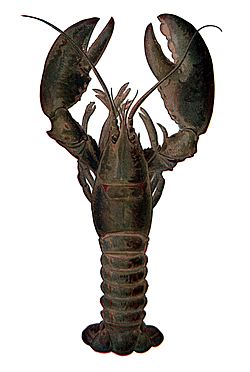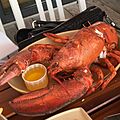Lobster facts for kids
Quick facts for kids Nephropidae |
|
|---|---|
 |
|
| American lobster, Homarus americanus | |
| Scientific classification | |
| Kingdom: | |
| Phylum: | |
| Subphylum: | |
| Class: | |
| Order: | |
| Family: |
Nephropidae
Dana, 1852
|
Lobsters are large sea creatures called crustaceans. They belong to the family of Nephropidae, sometimes also known as Homaridae. Lobsters are an important type of seafood that people enjoy eating.
Contents
All About Lobsters
Many different sea creatures are called lobsters. But when most people talk about lobsters, they mean clawed lobsters, like the Homarus genus. Clawed lobsters are not closely related to squat lobsters, spiny lobsters, or slipper lobsters, which do not have large claws. The closest relatives of clawed lobsters are reef lobsters and freshwater crayfish.
Smaller kinds of lobsters are sometimes called "lobsterettes". Lobsters are invertebrates, meaning they do not have a backbone. They have a hard outer shell, called an exoskeleton, which protects them. Like most arthropods, lobsters must shed this old shell to grow bigger. This process is called moulting. When lobsters moult, they are soft and weak, making them easy targets for other animals. Some lobsters even change color when they are moulting.
Lobsters live in the ocean, from near the shore to the edge of the continental shelf. They can be found on rocky, sandy, or muddy bottoms. They usually live alone in cracks or under rocks for safety.
Lobsters typically eat live food. This includes fish, mollusks, other crustaceans, worms, and some plants. If they need to, lobsters will also eat dead plants and animals. Lobsters usually do not eat other lobsters in the wild. However, if they are kept in small spaces, they might eat each other. Scientists have found pieces of lobster skin in the stomachs of some lobsters. This happens because lobsters eat their own shed skin after moulting.
Lobsters keep growing throughout their lives. Some lobsters can live for over 100 years and become very large! The Guinness World Records states that the biggest lobster ever found was from Nova Scotia, Canada. It weighed 20.14 kg (about 44.4 pounds).
Like most arthropods, lobsters are "bilaterally symmetrical." This means their left and right sides are mirror images of each other. However, lobsters with claws often have claws of different sizes. These different-sized claws help them do special tasks. A lobster's head is connected to its body in a part called the cephalothorax. A hard shell called the carapace covers this area. The carapace is made of a tough material called chitin. A lobster's head has two pairs of antennae and three pairs of jaws. Lobsters use their antennae to feel their surroundings because they cannot see very well. The back part of a lobster's body, called the abdomen, has legs and a tail fan.
Lobsters usually move slowly by walking on the seafloor. But when they are in danger and need to escape, they can swim backward very quickly. They do this by curling and uncurling their abdomen. Lobsters can move at a speed of 5 meters per second when escaping.
How Long Do Lobsters Live?
Lobsters can live for a long time in the wild. Scientists estimate they can live up to 45 to 50 years. It is hard to know their exact age.
Lobsters as Food
Lobster is a popular food, used in many dishes. Some famous recipes include lobster Newberg and lobster Thermidor. Lobster is also used in soups, bisques, lobster rolls, and a dish called cappon magro. Many people enjoy dipping lobster meat in clarified butter to make it taste even better.
Cooks usually boil or steam live lobsters. When a lobster is cooked, its shell changes color from blue to orange. This happens because the heat breaks down a protein called crustacyanin. This protein usually hides the orange color of a chemical called astaxanthin, which is naturally in the shell.
History of Lobster as Food
In North America, the American lobster did not become popular until the mid-1800s. People in New York and Boston started to enjoy it. Commercial lobster fishing grew after special boats called "lobster smacks" were invented. These boats had open tanks to keep lobsters alive during transport.
Before this time, lobster was often seen as food for poor people or servants in places like Maine, Massachusetts, and the Canadian Maritimes. Some stories say that servants even asked not to eat lobster more than twice a week, but there is no strong proof of this. For a long time, American lobster was mainly used as fertilizer for plants or as bait for fish. It was not seen as a fancy food until well into the 1900s.
How Lobsters are Graded
Caught lobsters are sorted into three types: new-shell, hard-shell, or old-shell. Lobsters that have just shed their shells (new-shell) are the most delicate. This means the price of American lobster often depends on how hard its shell is.
- New-shell lobsters have very thin shells. They also have less meat compared to their shell size. However, their meat is very sweet. These lobsters are so delicate that they are hard to transport far. So, new-shell lobsters are mostly sold in the towns where they are caught.
- Hard-shell lobsters have firm shells and can survive being shipped to bigger cities like Boston or New York. Their meat is not as sweet as new-shell lobsters, but they cost more because they can be transported further.
- Old-shell lobsters have not shed their shells since the previous season. Their meat has a stronger taste. These lobsters are the toughest and can be flown anywhere in the world and still arrive alive. Because they can be shipped globally, they are the most expensive.
Images for kids
-
Lobsters awaiting purchase in Trenton, Maine
See also
 In Spanish: Nefrópidos para niños
In Spanish: Nefrópidos para niños








